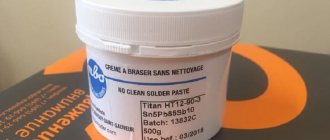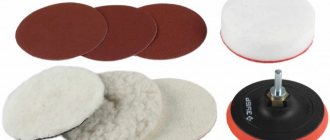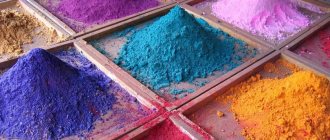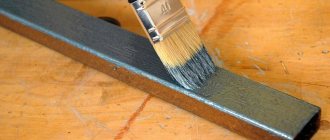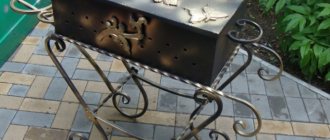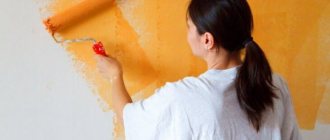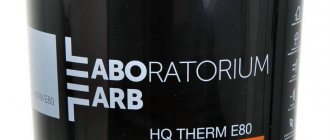Fiberglass wallpaper is a universal material for finishing walls and ceilings of any room. Previously, they were considered an office option, but the growing variety of textures, patterns and painting techniques have made it possible to use them in the design of living rooms.
The main advantage of the material is the ability to be repeatedly painted in different shades. To ensure that the properties of glass wallpaper are not lost, it is necessary to select high-quality paint and apply it according to technology.
Features of glass wallpaper
Fiberglass is a modern material with many advantages:
- Fiberglass wallpaper is made from a high-strength base. The material will be preserved even if it is attacked by domestic animals. This wallpaper is generally very resistant to mechanical damage.
- The material is highly resistant to fire.
- The surface of the glass wallpaper is resistant to the adhesion of dust and dirt, since the material contains an antistatic agent.
- Thanks to the antiseptic drug, the wallpaper is protected from the formation of fungus and mold.
- The composition of the final material includes specialized glass fabrics, which are characterized by resistance to wear. In addition, the fabrics are made from natural materials, which is good from the point of view of environmental friendliness and safety.
- Wallpaper of this type looks very respectable. There is a wide variety of textures, colors and patterns.
It is advisable to repaint glass wallpaper periodically, so it is recommended to purchase material with deep relief. In this case, the new paint will not overlap the old one. If there is a deep relief, the original texture will remain even after repeated staining.
What is glass wallpaper?
Fiberglass wallpaper is a finishing material for walls consisting of impregnated fiberglass. The surface has a relief pattern. Fiberglass wallpaper is made from glass blanks that melt under high temperature and the fibers stretch. These are subsequently used to create threads, and then fabric or fiberglass using the weaving method. Later, the surface is coated with impregnation to ensure the stability of the material.
Compound
Fiberglass wallpaper consists of natural materials: soda, clay, limestone, quartz sand. To transform from blanks into fiberglass, only high temperatures are required, reaching 1200 degrees. The basis of the impregnation, which is applied upon completion of the work to ensure the durability of the material, is modified starch.
Specifications
| Name | Meaning |
| Life time | more than 30 years |
| Possibility of coloring | Coloring up to 20 times |
| Standard size, (m.) | 1x25; 1x50 |
| Static electricity | Does not accumulate |
| Degree of vapor permeability | High |
| Fire properties | Eat |
| Minimum density of wallpaper for wall decoration | 100 gsm m. |
Paint selection
Paint for glass wallpaper should be water-dispersed - this is what most experts think. Water-dispersed compositions correspond to the following parameters:
- quick drying;
- no unpleasant odor;
- fast and deep impregnation of the material;
- non-toxic.
Since water-dispersed paint and varnish compositions contain a synthetic polymer substance, a film is formed on the surface as a result. This film acts as a buffer that protects the material from negative external influences.
Color options
One of the most important advantages of glass wallpaper is the ability to paint it in any color. You can choose your color scheme from millions of colors, tones, shades. Since the paint is sold in white, you will need to tint it (make the desired color) and here you can go in two different ways:
- You can tint the paint yourself using a specially sold coloring pigment or concentrate. At the same time, you will not be able to have a strong variation in color, since for an accurate match you will have to dilute the paint cans with a precise amount of color. For example, for a 1-liter can of paint, 1 can of color, or for a 7-liter container, 4 tubes of color. The advantage of this method is that you will always know how to mix additional paint if there is not enough.
- The second option for tinting paint is computer-based, which is done directly in the store. When choosing this method, you are not limited in colors and can choose any one. Experts will tell you exactly how the paint will look on the wall, since after application it often becomes a tone lighter. However, you should save the settings of the device in order to be able to make more coloring composition of the desired color in the future, but, unfortunately, this is not always possible, especially when it comes to subtle shades.
Contrasting interior of a living room
You should choose a color for painting the walls based on your preferences, but you should definitely listen to the recommendations of designers:
- For glass wallpaper, it is recommended to choose soft, discreet, calm colors. This color will be appropriate for all walls, it will not strain or put pressure, and later it can be easily changed to another by repainting it in 1-2 layers.
- For people who approach the interior creatively, who need a lively, contrasting design, we can suggest making bright inserts on the walls. Against the background of a calm general tone, they will look catchy and attract attention.
- Don't forget about your furniture, which should fit into the overall color concept of the room.
Using wallpaper stencils, you can add the necessary elements to the interior, while paint for glass wallpaper is also used for painting, but the color is different. If you have creative abilities, you can draw a picture on the wall. Try not to overdo it with the dimensions of the picture; for small rooms you should limit yourself to the appropriate images.
Painting walls by hand
Types of water-dispersion paints
There are three groups of water-dispersed compositions:
- Butadiene-styrene dispersions. This type of paint is highly resistant to moisture. However, these paints and varnishes also have a significant drawback - instability to ultraviolet radiation. Over time, surfaces painted with styrene-butadiene dispersions fade greatly, so they try to use such paints in rooms with windows facing north.
- Polyvinyl acetate paint and varnish compositions. Paints of this type are distinguished by their low prices. Polyvinyl acetate is not characterized by high water resistance, so its scope of application is dry rooms.
- Acrylic compositions. This type of paint and varnish material is characterized by maximum water resistance. Acrylic also tolerates ultraviolet radiation well. Another advantage of acrylic is quick drying. Acrylic paints are considered the best choice for painting fiberglass wallpaper.
Note! If you need additional protection of the room from fire, you can purchase special fire-resistant acrylic paint.
Surface care after applying paint and repainting
Features of glass wallpaper care are determined by the type of paint applied. If it is latex or acrylic, then it can be washed using non-abrasive detergents. It is no longer possible to remove dirt from polyvinyl acetate paint. To increase the service life of latex-based compositions, direct sunlight into the room should be limited.
In case of severe contamination, fading or wear, the paint is renewed. You can repeat the procedure an unlimited number of times. But with each layer the relief of the glass wallpaper will be smoothed out. The optimal number of stains is 5.
Advice! Glass wallpaper with a pronounced relief can be painted more times.
Fiberglass wallpaper is a high-quality and durable coating for walls and ceilings. Their use for decoration allows you to change the design and color scheme of the room at any time, repeatedly and quickly.
Manufacturers
The decision about what paint to paint glass wallpaper is largely dictated by a positive attitude towards a particular manufacturer. For example, the famous Finnish one is considered a manufacturer of very high-quality paints that have proven themselves over many decades.
The products of the German company, which produces paint for fiberglass wallpaper “Mattlatex Dufa”, are not so well known to the general consumer, but are of no worse quality.
As an example, we can cite the following types of paints for fiberglass wallpaper:
- "Tikkurila Harmony". This paint and varnish material is of high quality, quick drying and moderate consumption. "Tikkurila Harmony" has no pungent odor, is offered in a wide range of colors and at very affordable prices. It also produces matte paint, which can be used to give the surface a velvety feel.
- "Tikkurila Euro 2". The paint is made from acrylate copolymer containing latex. A matte palette is also available. The company recommends using the paint only for painting dry rooms.
- Mattlatex Dufa. The paint and varnish composition from the German company is characterized by high resistance to external influences and economical consumption. Mattlatex Dufa contains latex and the surface is matte.
What paint to paint glass wallpaper: washable latex and acrylic options
Using glass wallpaper in your interior is quite a smart step, especially if you choose high-quality wallpaper for painting. In previous articles, we have already talked about the properties of glass wallpaper, which distinguish them favorably from other similar finishing materials. In this article we will tell you how to paint glass wallpaper, because the finishing layer on the wall should be paint.
Good paint makes painting work enjoyable
Color selection
Once a manufacturer has been chosen, you can think about choosing the right paint shade. Most often, personal taste is decisive in this matter. However, when choosing, it is still recommended not to forget about some practical considerations:
- Bright, eye-catching colors may look attractive, but the mood will sooner or later change, and flashy shades can be very annoying. In addition, too bright colors usually get boring quickly.
- If you still want to make bright accents, it is recommended to use inserts with your favorite colors against a background of pastel colors.
- According to the rules of good taste, the color of the walls should be combined with the colors of furniture and other large interior items.
- Small patterns can change the geometric perception of a room, and large elements are suitable for rooms with a large area.
Advice! In small rooms, using several colors makes it possible to visually enlarge the room.
How to choose glass wallpaper?
Fiberglass wallpaper must be selected according to certain criteria, namely pattern, manufacturer, class and composition.
- The higher the density of the fiberglass material, the stronger the material and the longer the service life,
- fiberglass wallpaper of lower density is not so durable, but has a low cost,
- the pattern is selected depending on personal preferences, it is also possible to make an individual order for a unique pattern,
- the larger the drawing, the more times it can be covered with paint,
- the ideal composition is a ratio of 70% glass and 30% impregnation,
- The edges of the roll should be smooth and the weaving neat.
Sticking
First of all, paintable fiberglass wallpaper needs to be glued to the wall. Below are step-by-step instructions that will help you avoid mistakes during the gluing process:
- The optimal room temperature when applying wallpaper to the wall is from 18 to 25 degrees Celsius. Relative air humidity should not exceed 70%. If these conditions are neglected, the glue will dry unevenly. In addition, drafts and direct sunlight should be avoided, otherwise the surface will bubble.
- To glue glass wallpaper for painting, you need not just any glue, but a special glue. PVA glue or any other compositions where PVA is one of the components are not suitable. The fact is that when using PVA glue with glass wallpaper, unsightly yellow spots and stains will inevitably remain on the coating.
- Glue can be purchased both ready-made and in powder form. Glue consumption per square meter is usually indicated on the packaging.
- Before gluing glass wallpaper for painting, we prepare the surface. We clean the wall from the old coating. The surface must be perfectly flat, so we putty it and clean it first with coarse-grained and then fine-grained sandpaper. Next, we treat the surface with acrylic primer for indoors. We start gluing the wallpaper only after the surface has completely dried.
- If we are talking about wallpaper with a simple pattern, first cut a piece of canvas of a suitable size. The dimensions must correspond to the height of the room plus a 10 cm allowance to fit the pattern. Apply glue to one and a half pieces of canvas in an even layer. We glue the first canvas and at the same time use a plumb line so that the canvas is strictly vertical. Smooth the canvas along the wall (from the center towards the edges) using a plastic spatula. We remove the glue protruding along the edges of the canvas with a knife or spatula. Glue the following panels butt to the ones already glued.
- If we are talking about gluing wallpaper with a complex pattern, then you need to act a little differently. First, we cut the canvases, taking into account the repeat (the distance between the repeating elements of the pattern). Do not forget to leave 10-12 centimeters for adjusting the canvas. We number the cut pieces (on the reverse side). Rapport is always indicated on the product label. The indicator must be taken into account when planning the number of glass wallpapers per room.
- With wallpaper with a complex pattern, you can do it differently: refuse to make blanks and immediately start gluing. In this case, the canvas is adjusted to the drawing as you go. Otherwise, gluing glass wallpaper with a complex pattern is no different from gluing simple wallpaper.
Before painting the glass wallpaper with a pre-selected paint, you must wait until the glue on the surface has completely dried.
Selection of paints and varnishes for glass wallpaper
Despite popular belief, it is not always necessary to paint glass wallpaper. There are often situations when the original color of the material fits perfectly into the interior and does not require any adjustments. However, in most cases, fiberglass wallpaper is intended specifically for further coloring, and therefore has an inexpressive and unattractive gray-white tint, which can hardly be called aesthetic.
Wallpaper is painted precisely to increase its attractiveness; this procedure has nothing to do with the technical and functional characteristics of the material, which practically do not change after coating with paint.
We strongly recommend that you think about choosing colorants at the same time as purchasing glass wallpaper. The paint for glass wallpaper must be suitable and have a number of important performance qualities that will allow installation work to be completed with minimal labor and financial costs, and will also provide the room being decorated with an aesthetic appearance.
Almost all experienced specialists agree that it is best to paint wallpaper with water-dispersion or water-based paint. These substances meet all the criteria for glass wallpaper paint:
- short drying time;
- rapid penetration into the base structure;
- no strong odor;
- environmental friendliness.
Water-dispersed dyes are chosen more often. They contain aqueous dispersions of synthetic polymers. After application to the surface, the water evaporates, as a result of which the substance forms a dense protective film on the canvas. Water-dispersion paints differ from other paints in that they are diluted with water before use. In addition, it is presented on the market only in white; to give the dye other shades, it is necessary to use color.
To paint glass wallpaper, you can use one of three types of water-dispersed dye:
- Butadione-styrene dispersion. It is distinguished by increased moisture resistance characteristics, therefore it is suitable for use in “wet” areas of the apartment - in the kitchen, bathroom and toilet. It has a fairly significant drawback - fading in the sun, as a result of which it is not customary to use it in rooms that receive a large amount of sunlight.
- Polyvinyl acetate composition. It is characterized by low cost and limited possibilities for use. Due to their poor water resistance, such substances are recommended for use only in dry rooms.
- Acrylic paint. A universal dye, perfect for coloring glass wallpaper. It is resistant to ultraviolet exposure and high air humidity, and therefore can be used in all rooms without exception. Another advantage of acrylic compounds is that they allow you to wash lined surfaces, which greatly simplifies the procedure for caring for glass wallpaper.
Painting
Before applying paint, it is recommended to read the instructions on the packaging. The instructions indicate the consumption of paint and varnish material, drying time and other useful information.
It is recommended to prime the wallpaper with a roller. Without a primer, the surface will have insufficient adhesive qualities (adhesion of dissimilar materials), and the texture of the material will not be expressed as well as it could be.
We apply the paint and varnish material to the embossed glass wallpaper using a spray gun or roller. A brush will not provide the same even distribution of paint over the surface. Apply the dye in two layers. Apply the second layer 12 hours after the first.
You can paint glass wallpaper yourself in several ways:
- using borders;
- using stencils;
- squeegee method;
- using azure.
Curbs
When working with borders you should keep in mind:
- One textured pattern based on fiberglass is used both at the top and bottom of the border.
- The composition can use various texture solutions regarding the border.
When all the canvases are already on the wall, we glue the border. To ensure the work is done correctly, we mark the wall in advance. Apply the border only to a completely dry wall.
Stencils
Using a stencil does not just mean painting a surface, but creating geometric patterns. First, we carry out the main coloring of the canvas. After this, using masking tape, we apply the planned patterns to the surface of the glass wallpaper. At the same time, we apply the design very carefully, using a foam sponge. It is very important to avoid the paint material from flowing under the tape.
When the paint is completely dry, carefully remove the masking tape from the wall. The dried surface of the finished drawing can also be treated with paint - this time by hand.
Squeegee staining
This method is quite simple to implement. For the main color, deep and rich tones are suitable. After the first layer has dried, we apply a glaze coating that is similar in tone. For this purpose, decorative water-based varnish (translucent) or some other paint and varnish material with a metallic effect is suitable.
Without waiting for the coating to dry, remove excess paint using a moistened foam sponge. The goal is to leave paint only in the textured recesses of the relief coating.
Advice! Squeegee staining can also be done using a spatula (rubber or plastic).
Staining with azure
First, apply a layer of paint using a roller or spray gun. When the surface is dry, we begin to apply the glaze. We use a flat brush for this. The nature of the movements is transverse, in small strokes. After about 20 minutes, spread the mixture over the wallpaper with a rubber spatula. It is thanks to the spatula that you can achieve uniform distribution of the flakes over the surface.
If you need to get a more saturated color, we repeat the work done previously again or use a tone slightly different from the original one to give the surface visual depth.
Features of use on the ceiling
Gluing glass wallpaper is carried out according to the same principle as on walls. Self-adhesive tape will help you check the strength of old plaster on the ceiling.
- The direction starts from the window to the opposite wall.
- Glue is used only specifically for glass wallpaper; any other glue will not withstand their weight.
- The glue is applied only to the ceiling.
- You need to act sequentially, the next strip of glue is spread after the sheet of wallpaper is glued.
- The gluing is done end-to-end, with an overlap on the walls.
- The excess is cut off after drying.
Technology of painting glass wallpaper in the main color
When painting glass wallpaper, you must adhere to the general rules for carrying out repair work. Close windows and doors to the room, protect the floor and furniture from paint splashes. Painting should be done at room temperature - 18 - 22 degrees and humidity up to 40 - 50%. Under such conditions, the paint will dry gradually and evenly. You should not use heating devices to speed up the process, as this will dry some areas faster and others slower - this can lead to stains and streaks.
Surface preparation
Painting is carried out no earlier than 72 hours after gluing. The glue under the wallpaper must dry thoroughly before the next stage of processing is done.
The surface of the glass wallpaper must be primed - this improves adhesion to the paint layer, reduces the consumption of the finishing coating, smoothes out loose fibers and binds dust particles. For processing, you should use a special primer or a weakly concentrated solution of wallpaper glue. It is allowed to dry, then they begin to apply paint.
Tools
To apply paint, use a spray gun or a long-haired roller - they paint the relief best. For hard-to-reach areas: corners, junction lines with the floor and ceiling, you will need a narrow brush.
If the paint needs to be tinted before use, you should stock up on a construction mixer to thoroughly distribute the dye throughout the mass.
Application
Handling a spray gun requires experience and skill; non-professionals are better off using a roller. Staining is carried out according to the following scheme:
- Stir the paint before use.
- Pour a little into the cuvette.
- Dip the brush and remove excess paint from it.
- Paint corners and joint lines. It is important to ensure that the composition fills all the recesses on the glass wallpaper.
- Dip a roller into the paint and roll it along the top of the container so that the composition is distributed evenly throughout the coat.
- Paint the main part of the walls. Moving from the ceiling to the floor. A fresh strip should always overlap the previous one by a few millimeters. You will have to press lightly on the roller to paint the cavities.
It is best to start work from the corner, where the edge painted with a brush ends. During application, you should not take breaks, as a stripe will appear in the place where the process is stopped. Therefore, it is necessary to paint the entire room in one go.
Glass wallpaper is painted in two layers. The second is applied 12 hours after the first, according to similar instructions.
How many times can glass wallpaper be repainted?
Manufacturers guarantee the ability to paint glass wallpaper 7-8 times, and some up to 10-15 times.
If you don’t like the color, you can repaint it after the previous layer has dried well, i.e. no earlier than 10-12 hours later.
But don’t get carried away with repainting, since each subsequent layer evens out the texture of the picture. The wallpaper will become less expressive.
Frequent painting will make the wallpaper heavier, and the glue on which it sits may not be able to withstand its weight.
If you have any questions, complaints or want to leave your positive feedback, you can do so below! Leave your feedback and suggestions in the comments!
We will be very pleased if you find time and a reason to share your opinion!
